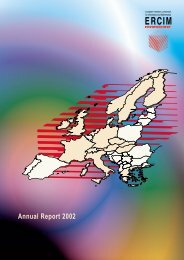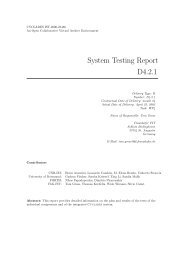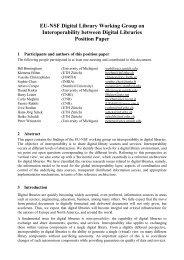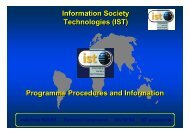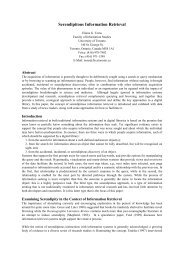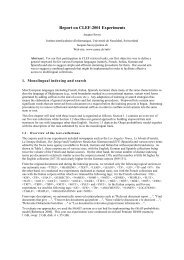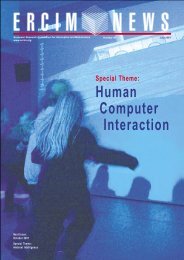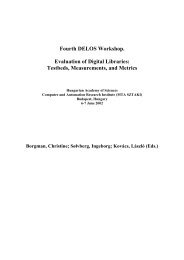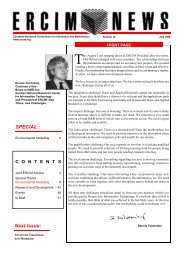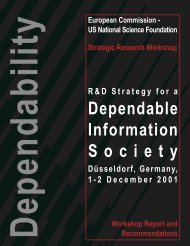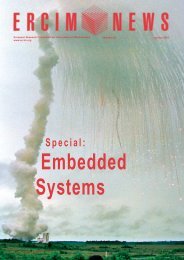Towards a Platform for Widespread Embedded Intelligence - ERCIM
Towards a Platform for Widespread Embedded Intelligence - ERCIM
Towards a Platform for Widespread Embedded Intelligence - ERCIM
You also want an ePaper? Increase the reach of your titles
YUMPU automatically turns print PDFs into web optimized ePapers that Google loves.
taking pictures at an event to merge their<br />
captures and provide a complete collection.<br />
Another interesting use of collaborative<br />
capture is to use several nodes to<br />
increase the quality or the accuracy of a<br />
given data, by combining their individual<br />
data.<br />
These applications, which can appear<br />
simple, raised difficult issues. Context<br />
descriptions of available resources and<br />
on-going capture processes should be<br />
accurate enough to allow sharing,<br />
without overloading the local communication<br />
medium to allow their efficient<br />
distribution on-the-field. Obviously, pri-<br />
Autarkic Power Generation<br />
<strong>for</strong> Networked Systems<br />
by Eberhard Mueller and Ulrich Hofman<br />
vacy is a big issue. For example, you<br />
may agree to share the pictures you are<br />
taking at a given event with only a few of<br />
the people present, but not the pictures<br />
taken an hour ago in another context.<br />
Traditional security, with authorisations,<br />
is difficult to apply in practice in the context<br />
of spontaneous interactions with<br />
new and potentially unknown nodes.<br />
Innovative approaches, based <strong>for</strong><br />
example on more dynamic notions such<br />
as trust and behaviour, have to be investigated<br />
be<strong>for</strong>e practical security mechanism<br />
<strong>for</strong> these systems can be found. In<br />
relation to trust, we must be able to rank<br />
the quality of the contributions, which<br />
A research project funded by the FIT-IT programme of the Austrian ministry <strong>for</strong><br />
traffic, innovation and technology (BMVIT) investigates the potential of different<br />
energy sources <strong>for</strong> communication purposes, especially <strong>for</strong> out-door activities.<br />
The economic relevance of this research<br />
activity can easily be seen by examining<br />
the ef<strong>for</strong>ts companies take to optimise<br />
the energy consumption of embedded<br />
devices. The use of alternative energy<br />
supply, like Piezo-Elements or Thermo-<br />
Elements, will thus be a great chance to<br />
achieve this goal so as to minimise costs<br />
and to make devices independent from<br />
external energy supply.<br />
Figure 1: Logical components of Unified Model.<br />
Energy management is not only considered<br />
in terms of minimising the energy<br />
consumption, but also as finding additional<br />
ways <strong>for</strong> energy to be supplied.<br />
Furthermore, the energy-consuming<br />
activities are bound to the current status<br />
of energy production and the current cost<br />
functions. For example, energy consuming<br />
communication tasks are carried<br />
out not continuously, but at optimal<br />
SPECIAL THEME: <strong>Embedded</strong> <strong>Intelligence</strong><br />
may include poor data, or even false<br />
data. Worse, the very notion of ubiquitous<br />
capture can be frightening: the<br />
potential capture activity of anyone, anywhere<br />
may change social relations<br />
between people. It's too late to do anything<br />
about that, this distributed infrastructure<br />
is already in our pockets!<br />
Link:<br />
http://www.irisa.fr/aces/<br />
Please contact:<br />
Paul Couderc, INRIA-IRISA, France<br />
E-mail: paul.couderc@inria.fr<br />
opportunities by episodic transmission<br />
protocols. This principle is verified using<br />
two very different application scenarios:<br />
skis and bicycles.<br />
The scientific aim of the project is to<br />
develop an innovative integrated framework<br />
and tool <strong>for</strong> modelling the energy<br />
and communication processes in networked<br />
embedded systems. Today's<br />
modelling approaches and tools are<br />
based on a combination of discreet modelling<br />
of the communication processes<br />
and an underlying model describing the<br />
energy consumption. The modelling and<br />
simulation of the energy processes in<br />
sinks (sensors, actuators, physical communication)<br />
and sources (generator, battery)<br />
are realised by means of continuous<br />
models.<br />
This two-paradigm approach has its disadvantages:<br />
• Handling two modelling approaches<br />
and isolated tools is difficult <strong>for</strong> the<br />
researchers/engineers and increases<br />
the duration of the development cycle.<br />
• Interfaces between different modelling<br />
approaches/tools have a potential <strong>for</strong><br />
misinterpretation by the experts in<br />
their respective domain.<br />
<strong>ERCIM</strong> News No. 67, October 2006 43



